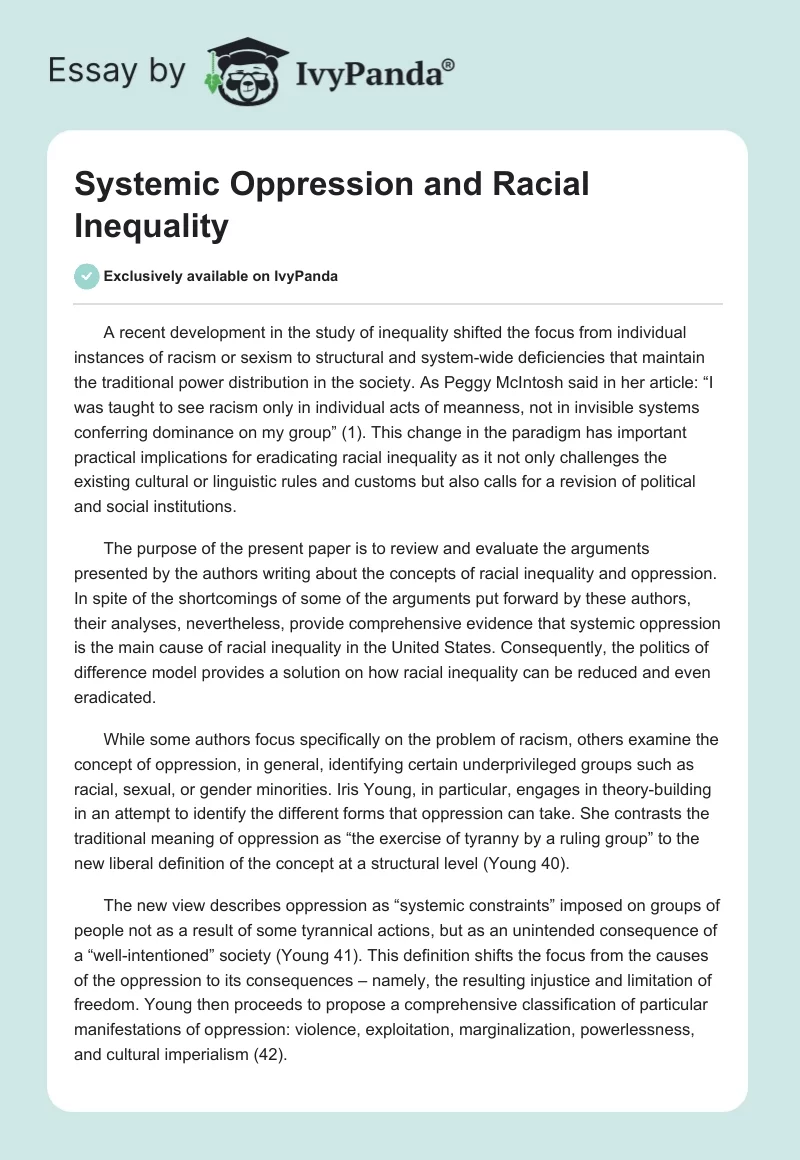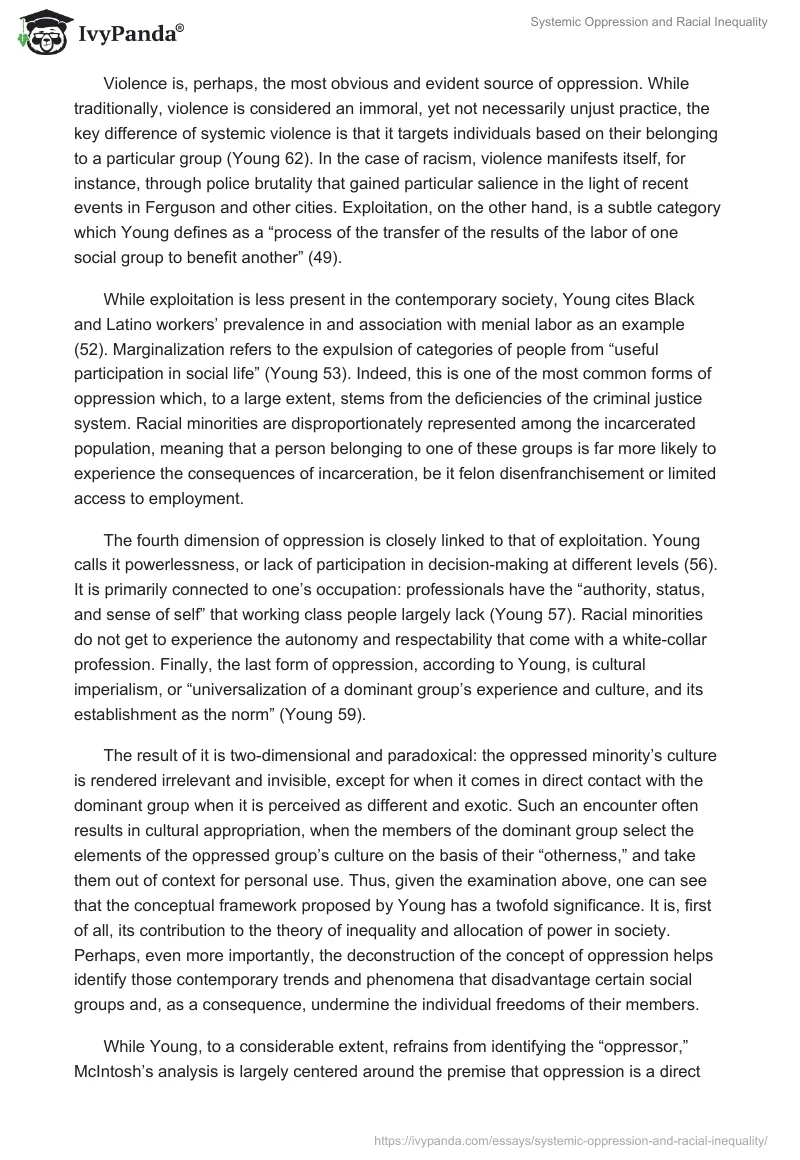A recent development in the study of inequality shifted the focus from individual instances of racism or sexism to structural and system-wide deficiencies that maintain the traditional power distribution in the society. As Peggy McIntosh said in her article: “I was taught to see racism only in individual acts of meanness, not in invisible systems conferring dominance on my group” (1). This change in the paradigm has important practical implications for eradicating racial inequality as it not only challenges the existing cultural or linguistic rules and customs but also calls for a revision of political and social institutions.
The purpose of the present paper is to review and evaluate the arguments presented by the authors writing about the concepts of racial inequality and oppression. In spite of the shortcomings of some of the arguments put forward by these authors, their analyses, nevertheless, provide comprehensive evidence that systemic oppression is the main cause of racial inequality in the United States. Consequently, the politics of difference model provides a solution on how racial inequality can be reduced and even eradicated.
While some authors focus specifically on the problem of racism, others examine the concept of oppression, in general, identifying certain underprivileged groups such as racial, sexual, or gender minorities. Iris Young, in particular, engages in theory-building in an attempt to identify the different forms that oppression can take. She contrasts the traditional meaning of oppression as “the exercise of tyranny by a ruling group” to the new liberal definition of the concept at a structural level (Young 40).
The new view describes oppression as “systemic constraints” imposed on groups of people not as a result of some tyrannical actions, but as an unintended consequence of a “well-intentioned” society (Young 41). This definition shifts the focus from the causes of the oppression to its consequences – namely, the resulting injustice and limitation of freedom. Young then proceeds to propose a comprehensive classification of particular manifestations of oppression: violence, exploitation, marginalization, powerlessness, and cultural imperialism (42).
Violence is, perhaps, the most obvious and evident source of oppression. While traditionally, violence is considered an immoral, yet not necessarily unjust practice, the key difference of systemic violence is that it targets individuals based on their belonging to a particular group (Young 62). In the case of racism, violence manifests itself, for instance, through police brutality that gained particular salience in the light of recent events in Ferguson and other cities. Exploitation, on the other hand, is a subtle category which Young defines as a “process of the transfer of the results of the labor of one social group to benefit another” (49).
While exploitation is less present in the contemporary society, Young cites Black and Latino workers’ prevalence in and association with menial labor as an example (52). Marginalization refers to the expulsion of categories of people from “useful participation in social life” (Young 53). Indeed, this is one of the most common forms of oppression which, to a large extent, stems from the deficiencies of the criminal justice system. Racial minorities are disproportionately represented among the incarcerated population, meaning that a person belonging to one of these groups is far more likely to experience the consequences of incarceration, be it felon disenfranchisement or limited access to employment.
The fourth dimension of oppression is closely linked to that of exploitation. Young calls it powerlessness, or lack of participation in decision-making at different levels (56). It is primarily connected to one’s occupation: professionals have the “authority, status, and sense of self” that working class people largely lack (Young 57). Racial minorities do not get to experience the autonomy and respectability that come with a white-collar profession. Finally, the last form of oppression, according to Young, is cultural imperialism, or “universalization of a dominant group’s experience and culture, and its establishment as the norm” (Young 59).
The result of it is two-dimensional and paradoxical: the oppressed minority’s culture is rendered irrelevant and invisible, except for when it comes in direct contact with the dominant group when it is perceived as different and exotic. Such an encounter often results in cultural appropriation, when the members of the dominant group select the elements of the oppressed group’s culture on the basis of their “otherness,” and take them out of context for personal use. Thus, given the examination above, one can see that the conceptual framework proposed by Young has a twofold significance. It is, first of all, its contribution to the theory of inequality and allocation of power in society. Perhaps, even more importantly, the deconstruction of the concept of oppression helps identify those contemporary trends and phenomena that disadvantage certain social groups and, as a consequence, undermine the individual freedoms of their members.
While Young, to a considerable extent, refrains from identifying the “oppressor,” McIntosh’s analysis is largely centered around the premise that oppression is a direct consequence of power dynamics between different social groups. She refers to it as “privilege” (McIntosh 1). Contrary to the original meaning of the word – that is, some special right or even honor – McIntosh uses this word as an umbrella term for different, most frequently mundane, instances of how one group enjoys a more constraint-free living environment. While McIntosh originally developed this concept in support of the feminist theories, she came to discover that unknowingly, white people also benefit from a privilege granted by their race.
Privilege concerns social interactions, access to education and healthcare, representation not only in government but also in entertainment, and experience with law enforcement, to name a few (McIntosh 32-35). McIntosh’s approach is highly effective as a tool to reach broader audiences: she names understandable and relatable activities to demonstrate how racial minorities are deprived of certain individual freedoms. This method allows her to draw attention to the fact that oppression is far more omnipresent than one may imagine. By identifying the white privilege, she also assigns responsibility to the members of the privileged group to work toward reducing the gap (McIntosh 1).
Where McIntosh in her analysis focuses on the individual level, Glassner, on the other hand, considers how one particular institution – the media – contributes to sustaining and perpetuating the oppression of racial minorities (Glassner 109). He examines how selective reporting, framing, and vocabulary choices influence and shape the public opinion. Even though Glassner refers to anecdotal evidence in his analysis, his main method of demonstrating the contradiction between real events and their media coverage is the juxtaposition of the media discourse and statistical evidence.
For instance, the growing prevalence of drug use and consequent violence in New York City in the late 1980s and early 1990s caused a widespread panic. The general perception was that anyone at any given time could become a victim of drug-related violence while it was true for only about two percent of all cases. Drug violence principally affected racial minority youths, especially Black men (Glassner 110-111).
Ironically, opinions similar to this one became the reason behind the failed War on Drugs which also had a disproportionate adverse impact on the Black community. Glassner’s argument has one particular shortcoming: by identifying the media as a “culprit” of racial prejudice and stereotyping, Glassner somewhat dismisses the complex and systemic nature of oppression by ignoring the intricate links between the media and the public opinion. While the media certainly has significant power over the public opinion, it is, in turn, also controlled by it. Thus, the media creates the content that is interesting to the reader, meaning that the Black narratives are largely irrelevant to the general public.
Yet another approach to the problem of racial inequality was undertaken by Edna Bonacich, who looked at it as a natural and even unavoidable consequence of power distribution in a capitalist society (198). As a consequence, the main argument in her writing refers to the wealth distribution in the American society, and it heavily relies on statistical data (Bonacich 191-195). While the specific figures that she quotes are no longer up-to-date, the general trend remains true: wealth is significantly concentrated in the hands of a small affluent elite, so wealth distribution is considerably skewed in the American society.
Racial minorities, given their limited access to education and employment, largely represent some of the poorest social groups in the United States. Yet, if one defines capitalism as a free-market economic model, Bonacich’s argument about the racial inequality being an inherent quality of capitalism does not hold true for other developed countries – at least not to the same degree. However, the predictions that she makes in the last section of her work have been confirmed: in recent years, the Black community has unified in its movement to demand justice and equality for racial minorities in the United States (Bonacich 205).
These authors, among many others, provide some compelling arguments demonstrating the reality of systemic oppression in the American society. On the one hand, these accounts are strikingly dissimilar, as these authors observed the same phenomena through a prism of their personal backgrounds and experiences. Conceptually, some of them even offer somewhat competing paradigms: for instance, their examination of the dominant group, as evident in the differences between the works of Young and McIntosh. At the same time, these analyses are internally consistent and mutually reinforcing: even though they examine the problem from a different angle, they identify the fundamental cause of the existing racial inequality rather similarly.
Even though it is quite thought-provoking to examine these works separately, they construct an even more interesting picture when they are put together. In fact, these analyses provide a comprehensive account of when and how oppression originated and how it was transformed and sustained throughout history up to the present day. These works examine the issue at the systemic, institutional, and individual levels of analysis, thus highlighting how the problem, stemming from structural constraints, permeates every sphere of social life.
Overt racism and systemic oppression can be compared to customs duties and non-tariff barriers: both ultimately hinder trade even if by overt or covert measures. Similarly, different forms of racism hinder inequality, even if through different methods. While it would be impossible to imagine such overtly racist legislation as the Jim Crow laws in contemporary America, currently, other pieces of legislation and, particularly, the design of the criminal justice system disproportionately affect the racial minorities. Besides, oppression is not only systemic – it is also cyclical and self-perpetuating: for instance, the unequal access to education creates unequal employment opportunities in the future.
Given the nature of the problem, the politics of difference model provides a more suitable solution to improving the racial relations in the American society, as opposed to liberal individualism. The latter model, as the name suggests, tends to focus on individual grievances which is equivalent to treating the symptoms rather than the cause of a disease. It is, undoubtedly, important to alleviate individual suffering and pain, but it should be accomplished by targeting the structural deficiencies leading to inequality.
Some may claim that the politics of difference approach is based on generalization and stereotypes, or that it only furthers the existing political and social cleavages. However, such a claim is unfounded since the politics of difference model has a different objective: social groups are identified because the system’s flaws concern the power distribution and dynamics between the dominant and minority groups, and the division is necessary to examine how power can be transferred between different groups.
Thus, the literature analysis revealed the convincing arguments and evidence demonstrating how the current sociopolitical infrastructure contributes to the oppression of racial minorities at the systemic level. Even though the individual instances of overt racism are still present these days, they are not the gravest concern when it comes to racial inequality. To achieve racial justice, the society and its members should strive to eliminate the structural constraints imposed on the racial minorities, and the politics of difference model presents a viable solution to this problem.


